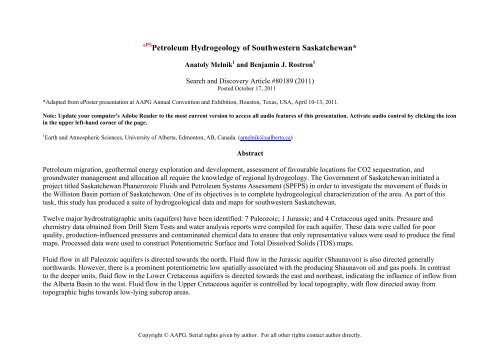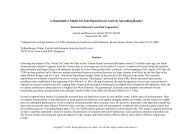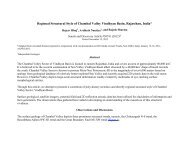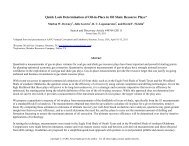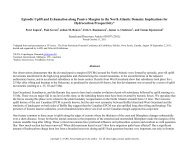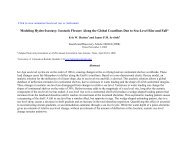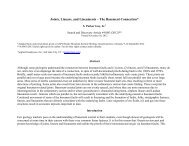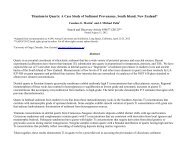Petroleum Hydrogeology of Southwestern Saskatchewan, #80189 ...
Petroleum Hydrogeology of Southwestern Saskatchewan, #80189 ...
Petroleum Hydrogeology of Southwestern Saskatchewan, #80189 ...
You also want an ePaper? Increase the reach of your titles
YUMPU automatically turns print PDFs into web optimized ePapers that Google loves.
ePS <strong>Petroleum</strong> <strong>Hydrogeology</strong> <strong>of</strong> <strong>Southwestern</strong> <strong>Saskatchewan</strong>*<br />
Anatoly Melnik 1 and Benjamin J. Rostron 1<br />
Search and Discovery Article <strong>#80189</strong> (2011)<br />
Posted October 17, 2011<br />
*Adapted from ePoster presentation at AAPG Annual Convention and Exhibition, Houston, Texas, USA, April 10-13, 2011.<br />
Note: Update your computer's Adobe Reader to the most current version to access all audio features <strong>of</strong> this presentation. Activate audio control by clicking the icon<br />
in the upper left-hand corner <strong>of</strong> the page.<br />
1 Earth and Atmospheric Sciences, University <strong>of</strong> Alberta, Edmonton, AB, Canada. (amelnik@ualberta.ca)<br />
Abstract<br />
<strong>Petroleum</strong> migration, geothermal energy exploration and development, assessment <strong>of</strong> favourable locations for CO2 sequestration, and<br />
groundwater management and allocation all require the knowledge <strong>of</strong> regional hydrogeology. The Government <strong>of</strong> <strong>Saskatchewan</strong> initiated a<br />
project titled <strong>Saskatchewan</strong> Phanerozoic Fluids and <strong>Petroleum</strong> Systems Assessment (SPFPS) in order to investigate the movement <strong>of</strong> fluids in<br />
the Williston Basin portion <strong>of</strong> <strong>Saskatchewan</strong>. One <strong>of</strong> its objectives is to complete hydrogeological characterization <strong>of</strong> the area. As part <strong>of</strong> this<br />
task, this study has produced a suite <strong>of</strong> hydrogeological data and maps for southwestern <strong>Saskatchewan</strong>.<br />
Twelve major hydrostratigraphic units (aquifers) have been identified: 7 Paleozoic; 1 Jurassic; and 4 Cretaceous aged units. Pressure and<br />
chemistry data obtained from Drill Stem Tests and water analysis reports were compiled for each aquifer. These data were culled for poor<br />
quality, production-influenced pressures and contaminated chemical data to ensure that only representative values were used to produce the final<br />
maps. Processed data were used to construct Potentiometric Surface and Total Dissolved Solids (TDS) maps.<br />
Fluid flow in all Paleozoic aquifers is directed towards the north. Fluid flow in the Jurassic aquifer (Shaunavon) is also directed generally<br />
northwards. However, there is a prominent potentiometric low spatially associated with the producing Shaunavon oil and gas pools. In contrast<br />
to the deeper units, fluid flow in the Lower Cretaceous aquifers is directed towards the east and northeast, indicating the influence <strong>of</strong> inflow from<br />
the Alberta Basin to the west. Fluid flow in the Upper Cretaceous aquifer is controlled by local topography, with flow directed away from<br />
topographic highs towards low-lying subcrop areas.<br />
Copyright © AAPG. Serial rights given by author. For all other rights contact author directly.
TDS values in the Paleozoic aquifers range from 5 g/L in the south to over 300 g/L in the north. In the southern part <strong>of</strong> the study area, where<br />
TDS values are relatively low (< 50 g/L), the water's chemical concentration appears to be diluted by freshwater recharge from the Montana<br />
highlands. Overlying Jurassic and Cretaceous aquifers have relatively low TDS content ranging from 5 g/L to 30 g/L.<br />
This study will be completed by construction <strong>of</strong> fresh water and density corrected driving force (DFR) maps and representative vertical hydraulic<br />
cross-sections. The combined results will be used to produce a complete regional characterization <strong>of</strong> subsurface fluid flow in southwestern<br />
<strong>Saskatchewan</strong>.<br />
Reference<br />
Hubbert, M. K., 1953, Entrapment <strong>of</strong> petroleum under hydrodynamic conditions: AAPG Bulletin, v. 37, p. 1954-2026.
PETROLEUM HYDROGEOLOGY OF<br />
SOUTHWESTERN SASKATCHEWAN<br />
A.Melnik and B.J.Rostron
OUTLINE<br />
1. Introduction – Project Overview<br />
2. Geology and Hydrostratigraphy<br />
3. Data Collection and Analysis<br />
4. Results – Maps<br />
5. Results – Cross-Sections<br />
6. Applications: Case Study<br />
7. Summary
INTRODUCTION<br />
The Project<br />
<strong>Saskatchewan</strong> Phanerozoic Fluids and <strong>Petroleum</strong> Systems assessment<br />
Study Objectives<br />
1. Detailed hydrogeologic characterization<br />
2. Density-dependent flow<br />
3. Hydrocarbon migration and entrapment<br />
Study Area<br />
Applications<br />
1. <strong>Petroleum</strong> exploration<br />
2. CO2 sequestration<br />
3. Groundwater management
GEOLOGY – BRIEF SUMMARY<br />
Paleozoic<br />
• Carbonate and evaporite dominated<br />
sequences with minor siliciclastics.<br />
• Dipping towards the south/southeast<br />
(Williston Basin center)<br />
Mesozoic<br />
• Siliclastic rocks with several<br />
carbonate formations in Jurassic.<br />
• Dipping towards the south<br />
• Truncating Paleozoic sediments
HYDROSTRATIGRAPHY<br />
Upper Cretaceous<br />
Lower Cretaceous<br />
Jurassic<br />
Mississippian<br />
Lower Paleozoic<br />
Detailed Hydrostratigraphy<br />
Based on<br />
1. Geology (SMER)<br />
2. New data<br />
3. Previous studies<br />
Aquifer Groups - Summary<br />
• Lower Paleozoic – 6 Aquifers<br />
• Mississippian – 1 Aquifer<br />
• Jurassic – 1 Aquifer<br />
• Lower Cretaceous – 3 Aquifers<br />
• Upper Cretaceous – 1 Aquifer<br />
Total <strong>of</strong> 12 aquifers
DATA COLLECTION AND ANALYSIS<br />
Data Types<br />
1. Formation pressures from Drill Stem Tests (DSTs)<br />
2. Water chemistry reports<br />
Data Collection<br />
1. Exported data from commercial databases<br />
2. QUALITY CONTROL<br />
Data Analysis<br />
1. Total Dissolved Solids (TDS) and water density.<br />
2. Freshwater hydraulic head (potential)<br />
3. Density-dependent Water Driving Forces (WDFs)
RESULTS - MAPS<br />
Lower Paleozoic – Winnipegosis Aquifer<br />
TDS (Salinity)<br />
• Low TDS in the south (300 g/L)<br />
• Spatial correlation to Prairie<br />
Evaporite edge<br />
Fluid Flow<br />
• Flow towards the north<br />
• Low gradients<br />
• Significant density effects
RESULTS - MAPS<br />
Mississippian – Mississippian Aquifer<br />
TDS (Salinity)<br />
• Generally low TDS throughout<br />
the area (
RESULTS - MAPS<br />
Jurassic – Shaunavon Aquifer<br />
TDS (Salinity)<br />
• Generally low TDS throughout<br />
the area (
RESULTS - MAPS<br />
Lower Cretaceous – Lower Mannville Aquifer<br />
TDS (Salinity)<br />
• Generally low TDS throughout<br />
the area (50 g/L):<br />
• Cross-formational flow from<br />
Paleozoic aquifers<br />
Fluid Flow<br />
• Flow towards the east/northeast<br />
• Moderate rates<br />
• No density effects
RESULTS - MAPS<br />
Upper Cretaceous – Belly River Aquifer<br />
TDS (Salinity)<br />
• Very low TDS (
RESULTS – CROSS-SECTIONS<br />
TDS (Salinity)<br />
• Freshwater input from south (
RESULTS – CROSS-SECTIONS<br />
Fluid Flow<br />
• Flow is generally towards the north<br />
• Highest hydraulic heads are observed in the Mississippian Aquifer (South)<br />
• Paleozoic units discharge fluids into Lower Cretaceous Aquifers (North)<br />
• Topography controlled flow in Upper Cretaceous Belly River Aquifer.
APPLICATIONS<br />
CASE STUDY: Hydrodynamic Entrapment in Shaunavon Formation<br />
Shaunavon Formation (Jurassic)<br />
• Carbonate cemented sandstones and shales<br />
• Medium-heavy crude trapped along<br />
“Shaunavon Oil Trend”<br />
Shaunavon Structure Map<br />
Hydrodynamics<br />
• UVZ method – Hubbert, 1953<br />
• Shaunavon oil is trapped hydrodynamically<br />
• Oil has migrated from south<br />
22 o API Oil Potential Maps 35 o API<br />
Oil is trapped<br />
DOWNDIP
SUMMARY<br />
1. Twelve major aquifers or aquifer systems have been identified for southwestern<br />
<strong>Saskatchewan</strong>.<br />
2. Lower Paleozoic aquifers have a wide range <strong>of</strong> TDS values; more than 300 g/L where<br />
Prairie Evaporite Formation is present. Mississippian and all Mesozoic aquifers have low<br />
TDS values; less than 30 g/L.<br />
3. Fluid flow in Paleozoic and Jurassic aquifers is generally towards the north. Fluid flow in<br />
Lower Cretaceous aquifers in towards east and northeast. Upper Cretaceous aquifer has<br />
local scale topographically driven flow from high to low elevation areas.<br />
4. Significant density-related flow effects are present in Lower Paleozoic aquifers.<br />
5. Hydrodynamic trapping conditions have been identified in Shaunavon and other aquifers.<br />
Reference<br />
Hubbert, M. K., 1953. Entrapment <strong>of</strong> petroleum under hydrodynamic conditions. American Association <strong>of</strong> <strong>Petroleum</strong> Geologists Bulletin,<br />
v. 37, p. 1954-2026.
THANK YOU FOR ATTENTION<br />
Questions?<br />
Contact Information<br />
Anatoly Melnik: amelnik@ualberta.ca<br />
Benjamin Rostron: ben.rostron@ualberta.ca


